Ditapis dengan

Applied Physic
- Edisi
- -
- ISBN/ISSN
- -
- Deskripsi Fisik
- -
- Judul Seri
- -
- No. Panggil
- 621 AIR a
- Edisi
- -
- ISBN/ISSN
- -
- Deskripsi Fisik
- -
- Judul Seri
- -
- No. Panggil
- 621 AIR a

Indeks of Airworthiness Directive Applicable
- Edisi
- -
- ISBN/ISSN
- -
- Deskripsi Fisik
- -
- Judul Seri
- -
- No. Panggil
- 629 DIR a
- Edisi
- -
- ISBN/ISSN
- -
- Deskripsi Fisik
- -
- Judul Seri
- -
- No. Panggil
- 629 DIR a

VOL ADVISORY CIRCULAR 170-02
- Edisi
- -
- ISBN/ISSN
- -
- Deskripsi Fisik
- -
- Judul Seri
- -
- No. Panggil
- 629 DIR a
- Edisi
- -
- ISBN/ISSN
- -
- Deskripsi Fisik
- -
- Judul Seri
- -
- No. Panggil
- 629 DIR a

DGAC Advisory Circular Vol 5
- Edisi
- -
- ISBN/ISSN
- -
- Deskripsi Fisik
- -
- Judul Seri
- -
- No. Panggil
- 629 DIR a
- Edisi
- -
- ISBN/ISSN
- -
- Deskripsi Fisik
- -
- Judul Seri
- -
- No. Panggil
- 629 DIR a

DGAC Advisory Circular Vol 4
- Edisi
- -
- ISBN/ISSN
- -
- Deskripsi Fisik
- -
- Judul Seri
- -
- No. Panggil
- 629 DIR a
- Edisi
- -
- ISBN/ISSN
- -
- Deskripsi Fisik
- -
- Judul Seri
- -
- No. Panggil
- 629 DIR a

DGAC Advisory Circular Vol 3
- Edisi
- -
- ISBN/ISSN
- -
- Deskripsi Fisik
- -
- Judul Seri
- -
- No. Panggil
- 629 DIR a
- Edisi
- -
- ISBN/ISSN
- -
- Deskripsi Fisik
- -
- Judul Seri
- -
- No. Panggil
- 629 DIR a

DGAC Advisory Circular Vol 2
- Edisi
- -
- ISBN/ISSN
- -
- Deskripsi Fisik
- -
- Judul Seri
- -
- No. Panggil
- 629 DIR a
- Edisi
- -
- ISBN/ISSN
- -
- Deskripsi Fisik
- -
- Judul Seri
- -
- No. Panggil
- 629 DIR a

DGAC Advisory Circular Vol 1
- Edisi
- -
- ISBN/ISSN
- -
- Deskripsi Fisik
- -
- Judul Seri
- -
- No. Panggil
- 629 DIR a
- Edisi
- -
- ISBN/ISSN
- -
- Deskripsi Fisik
- -
- Judul Seri
- -
- No. Panggil
- 629 DIR a
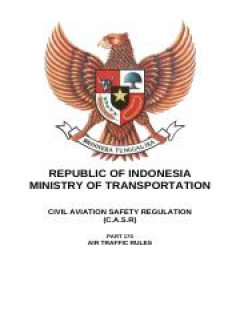
Cetak CASR (Civil Aviation Safety Regulation) − Part 170 Aircraft Rules
Bahwa dalam Peraturan Menteri Perhubungan Nomor PM 65 Tahun 2017 tentang Peraturan Keselamatan Penerbangan Sipil Bagian 170 ( Civil Aviation Safety Regulation Part 170) tentang Peraturan Lalu Lintas Udara (Air Traffic Rules) mengatur tentang pemberian kode Secondary Surveillance Radar (SSR); Bahwa ICAO memberikan Alokasi SSR Code untuk setiap Negara anggota ICAO yang diterbitkan melalui doku…
- Edisi
- -
- ISBN/ISSN
- -
- Deskripsi Fisik
- -
- Judul Seri
- -
- No. Panggil
- 629.132 3 MIN a
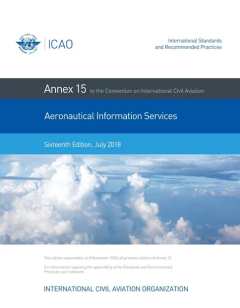
ANNEX 15 Aeronautical Information Services
- Edisi
- -
- ISBN/ISSN
- ANN-00015-016-01
- Deskripsi Fisik
- -
- Judul Seri
- -
- No. Panggil
- 629.136 6 INT a
- Edisi
- -
- ISBN/ISSN
- ANN-00015-016-01
- Deskripsi Fisik
- -
- Judul Seri
- -
- No. Panggil
- 629.136 6 INT a
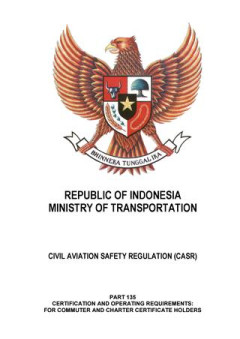
Cetak CASR (Civil Aviation Safety Regulation) − Part 135 Cert. & Opr. Req; …
The kinds of CASR Part 135 fixed wing airplane operations can be authorized as follows: (1) Commuter Airplane. Commuter airplane operations are conducted pursuant to CASR 135. This kind of operation authorizes carriage of passengers and cargo in scheduled operations. A certificate holder authorized for commuter airplane operations is automatically authorized to conduct on demand (nonsche…
- Edisi
- -
- ISBN/ISSN
- -
- Deskripsi Fisik
- -
- Judul Seri
- -
- No. Panggil
- 629.130 2 MIN c
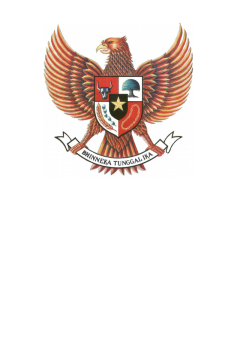
Cetak CASR (Civil Aviation Safety Regulation) − Part 121 Certification & Op…
New rules for operators conducting air transport in larger aeroplanes commence on 2 December 2021. Air transport is a new term that replaces both charter and regular public transport (RPT) and adds medical transport operations such as patient transport. The air transport rules for larger aeroplanes are in Civil Aviation Safety Regulations (CASR) Part 121. CASR Part 121 should be read with…
- Edisi
- -
- ISBN/ISSN
- -
- Deskripsi Fisik
- -
- Judul Seri
- -
- No. Panggil
- 629.130 2 MIN c
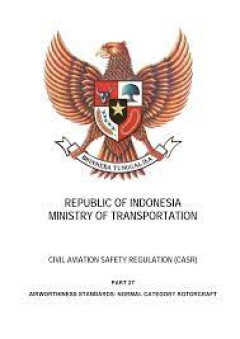
Cetak CASR (Civil Aviation Safety Regulation) − CASR Part 27 Airworthiness …
Part 27 of CASR was developed to specify the airworthiness standards for normal category rotorcraft (such as helicopters). These are rotorcraft with a maximum take-off weight (MTOW) up to 3,175 kg and up to nine passenger seats. Part 27 has been based on foreign legislation, specifically the USA's Federal Aviation Regulations Part 27.
- Edisi
- -
- ISBN/ISSN
- -
- Deskripsi Fisik
- -
- Judul Seri
- -
- No. Panggil
- 629.133 352 MIN a
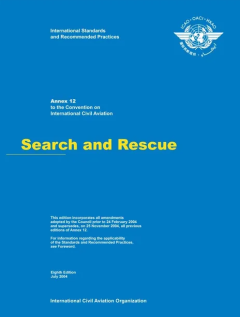
ANNEX 12 Search and Rescue
Annex, which is complemented by a three-part Search and Rescue Manual dealing with SAR organization, management and procedures, sets forth the provisions for the establishment, maintenance and operation of search and rescue services by ICAO Contracting States in their territories and over the high seas. Proposals for Annex 12 were originally made in 1946. By 1951, the proposals had been reviewe…
- Edisi
- -
- ISBN/ISSN
- ANN-00012-008-01
- Deskripsi Fisik
- -
- Judul Seri
- -
- No. Panggil
- 629.135 4 INT s
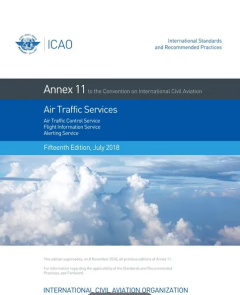
ANNEX 11 Air Traffic Services
The Standards and Recommended Practices applicable to Aeronautical Charts
- Edisi
- -
- ISBN/ISSN
- ANN-00011-015-01
- Deskripsi Fisik
- -
- Judul Seri
- -
- No. Panggil
- 629.136 6 IINT a

Cetak CASR (Civil Aviation Safety Regulation) − Part 69 Air Traffic Service…
bahwa dalam Peraturan Menteri Nomor 1 Tahun 2014 tentang Peraturan Keselamatan Penerbangan Sipil Bagi 69 {Civil Aviation Safety Regulation Part 69) Tentang Lisen^i Rating, Pelatihan Dan Kecakapan Personel Navig Penerbangan, diatur ketentuan lebih lanjut diatur deng^n Peraturan Direktur Jenderal;
- Edisi
- -
- ISBN/ISSN
- -
- Deskripsi Fisik
- -
- Judul Seri
- -
- No. Panggil
- 629.130 2 MIN a
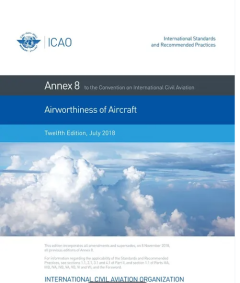
ANNEX 8 Airworthiness of Aircraft
Annex 8 includes broad standards which define, for application by the national airworthiness authorities, the minimum basis for the recognition by States of Certificates of Airworthiness for the purpose of flight of aircraft of other States into and over their territories, thereby achieving, among other things, protection of other aircraft, third parties and property. It is recognized that ICAO…
- Edisi
- -
- ISBN/ISSN
- ANN-00008-012-01
- Deskripsi Fisik
- -
- Judul Seri
- -
- No. Panggil
- 629.132 3 INT a
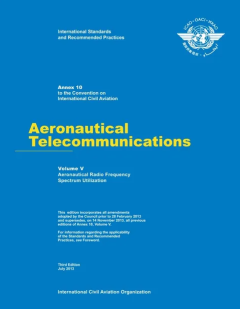
ANNEX 10 Aeronautical Telecomunication
Volume V of Annex 10 contains Standards and Recommended Practices and guidance material on the utilization of aeronautical frequencies.
- Edisi
- -
- ISBN/ISSN
- ANN-00010-003-05
- Deskripsi Fisik
- -
- Judul Seri
- -
- No. Panggil
- 629.132 51 INT a

Cetak CASR (Civil Aviation Safety Regulation) − CASR Part 61 Licensing of P…
Part 61 of CASR 1998 prescribes the requirements and standards for the issue of flight crew licences, ratings and other authorisations, including those issued to pilots and flight engineers. It also includes the privileges, limitations and conditions on such authorisations, and rules for the logging of flight time.
- Edisi
- -
- ISBN/ISSN
- -
- Deskripsi Fisik
- -
- Judul Seri
- -
- No. Panggil
- 629.130 2 MIN l

Cetak CASR (Civil Aviation Safety Regulation) − Part 36 Noise Standards: A/…
- Edisi
- -
- ISBN/ISSN
- -
- Deskripsi Fisik
- -
- Judul Seri
- -
- No. Panggil
- 629.130 2 MIN n
- Edisi
- -
- ISBN/ISSN
- -
- Deskripsi Fisik
- -
- Judul Seri
- -
- No. Panggil
- 629.130 2 MIN n
 Karya Umum
Karya Umum  Filsafat
Filsafat  Agama
Agama  Ilmu-ilmu Sosial
Ilmu-ilmu Sosial  Bahasa
Bahasa  Ilmu-ilmu Murni
Ilmu-ilmu Murni  Ilmu-ilmu Terapan
Ilmu-ilmu Terapan  Kesenian, Hiburan, dan Olahraga
Kesenian, Hiburan, dan Olahraga  Kesusastraan
Kesusastraan  Geografi dan Sejarah
Geografi dan Sejarah